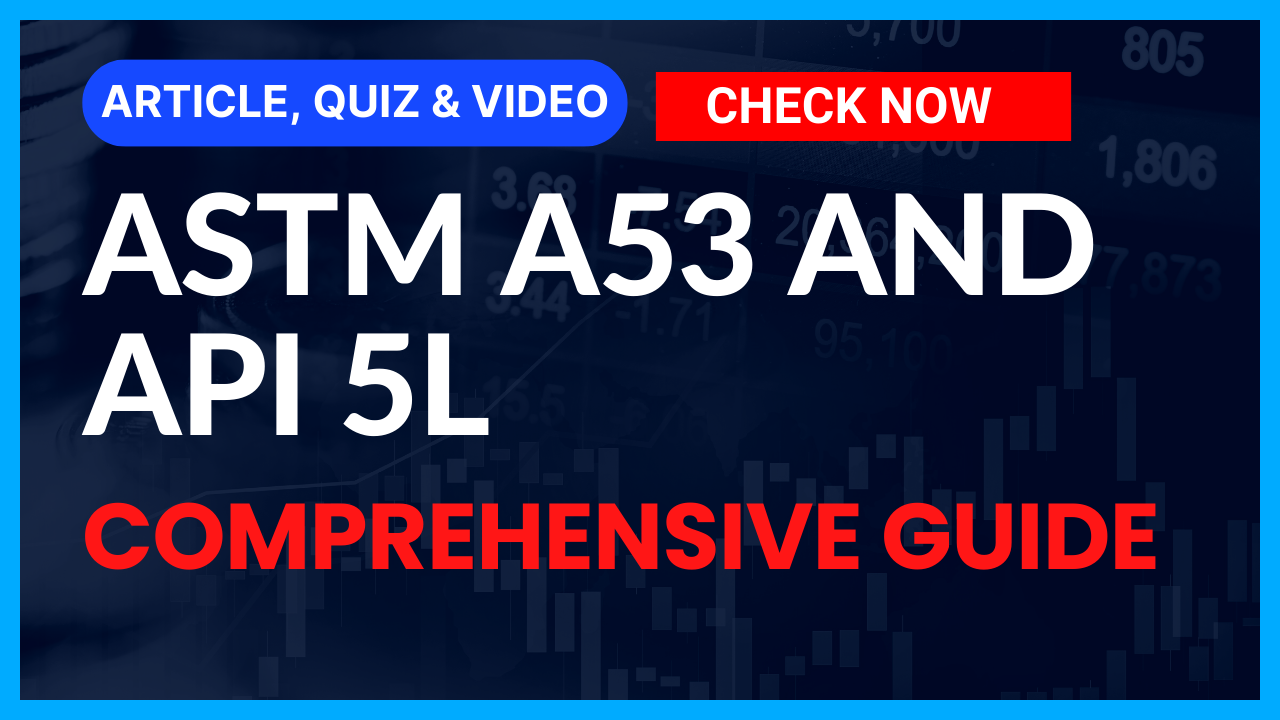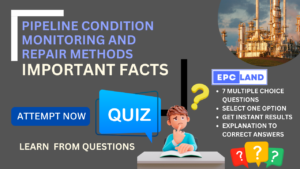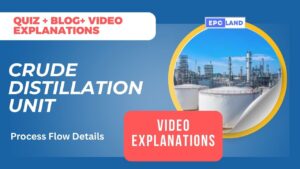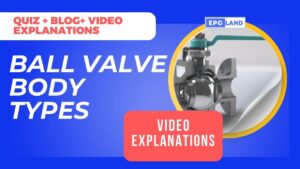Introduction
Steel pipes play a pivotal role in modern society, serving as essential components in a wide range of industries, including construction, oil and gas, water supply, and more. These pipes are used to transport fluids, gases, and other substances over short and long distances, making them a fundamental element of infrastructure and industrial operations. However, not all steel pipes are created equal; their suitability for different applications relies on adhering to specific standards that ensure their quality, performance, and safety.
In this comparative analysis, we delve into two prominent standards in the realm of steel pipes: ASTM A53 and API 5L. Both standards carry significant weight in determining the characteristics of steel pipes, but they cater to distinct applications and industries. Understanding the nuances of ASTM A53 and API 5L standards is essential for engineers, project managers, and decision-makers tasked with selecting the most appropriate pipes for their specific requirements.
Table of Contents
Do not miss the detailed course 7 Modules of Piping Codes & Standards
Enrollment link
Check out the Similar Articles on ASTM Standards
Importance of Selecting the Appropriate Standard: ASTM A53 and API 5L
The choice between ASTM A53 and API 5L standards can greatly influence the success of a project and the performance of the steel pipes. While both standards establish guidelines for manufacturing and testing, they address different aspects of steel pipes and are optimized for specific use cases. The consequences of using the wrong standard can range from reduced efficiency and increased maintenance costs to compromising the safety of personnel and the environment.
As the article unfolds, we will delve into the details of each standard, exploring their scope, material composition requirements, mechanical properties, testing procedures, and application domains. By the end of this analysis, readers will be equipped with the knowledge needed to make informed decisions regarding the selection of either ASTM A53 or API 5L standards for their steel pipe needs.
ASTM A53 Standard
Significance and Relevance: ASTM A53 is a widely recognized standard developed by the American Society for Testing and Materials (ASTM). This standard sets the guidelines for manufacturing both seamless and welded steel pipes, making it a crucial reference for industries requiring pipes with diverse applications, such as structural, plumbing, and mechanical systems.
Scope and Classification: The scope of ASTM A53 covers a wide range of pipe types and sizes, facilitating its adoption across various industries. The standard classifies pipes into three distinct types, each designed to cater to specific needs:
- Type F: Furnace-butt welded, continuous weld, or electric resistance welded (ERW) pipes. These pipes are commonly used for non-pressure applications such as structural framing and fencing.
- Type E: Electric resistance welded (ERW) pipes. They are suited for structural applications and are often used in low-pressure fluid transportation systems.
- Type S: Seamless pipes, which provide enhanced strength and pressure-bearing capabilities. They are employed in applications demanding higher pressure resistance, such as steam systems and pressure vessels.
Requirements: ASTM A53 outlines stringent requirements for both chemical composition and mechanical properties of steel pipes. These requirements ensure that the pipes meet specified standards of durability, strength, and performance. The chemical composition specifications dictate the allowable elements and their concentration limits, while the mechanical properties encompass tensile strength, yield strength, elongation, and hardness. Additionally, the standard mandates various testing procedures, including hydrostatic testing, non-destructive inspection, and dimensional checks, to ensure the quality and integrity of the pipes.
Applications: ASTM A53 pipes find applications in a variety of industries, including construction, plumbing, agriculture, and general engineering. They are suitable for conveying non-corrosive fluids, gases, and solids in both indoor and outdoor settings. While ASTM A53 pipes exhibit versatility, their usage is typically limited to environments where high-pressure resistance is not the primary concern.
In the following sections, we will delve into the API 5L standard, elucidating its purpose, scope, grade classification, and key requirements. This comparative analysis aims to equip readers with the knowledge needed to discern between ASTM A53 and API 5L standards, ultimately aiding in making well-informed decisions when selecting steel pipes for specific applications.
Do not miss the detailed course 7 Modules of Piping Codes & Standards
Enrollment link
API 5L Standard
Introduction and Significance: The American Petroleum Institute (API) developed the API 5L standard to address the specific requirements for steel pipes used in the transportation of liquids, gases, and other substances within the oil, gas, and water industries. This standard is of paramount importance in ensuring the safety, reliability, and efficiency of pipelines used for energy transportation.
Scope and Grades: API 5L specifies the requirements for line pipes, which are primarily used in pipelines for the transmission of oil, gas, and water. The standard encompasses a range of grades, each denoted by a numerical indicator and divided into two performance levels: PSL1 (Primary Service Level 1) and PSL2 (Primary Service Level 2). PSL1 pipes have lower requirements for chemical composition and mechanical properties, while PSL2 pipes adhere to more stringent standards, including additional testing and inspection requirements.
Requirements and Specifications: API 5L outlines comprehensive requirements for both chemical composition and mechanical properties of the steel pipes. These requirements are tailored to the specific grade and level, ensuring that the pipes can withstand the conditions of their intended use. The chemical composition standards include limits on elements such as carbon, manganese, sulfur, phosphorus, and others. Mechanical properties, including tensile strength, yield strength, and impact toughness, vary according to the grade and level.
Testing and Quality Control: API 5L places a strong emphasis on testing and inspection to guarantee the integrity of the pipes. Non-destructive testing methods, such as ultrasonic testing and radiographic examination, are employed to identify defects that might compromise the structural integrity of the pipes. Hydrostatic testing is also a crucial component to assess the pressure-bearing capacity of the pipes and ensure they are suitable for the intended application.
Applications: API 5L pipes are used primarily in industries that require the transportation of oil, gas, and water over long distances. They are an essential component of energy infrastructure, connecting extraction points to refineries and distribution networks. The standard’s focus on durability, strength, and reliability makes API 5L pipes an indispensable choice for the challenging conditions present in the oil and gas industry.
With the understanding gained from our exploration of both ASTM A53 and API 5L standards, we will proceed to conduct a comprehensive comparative analysis, highlighting the differences and similarities between the two. This analysis will facilitate a deeper understanding of the factors influencing the choice between these standards and the implications of that choice on the performance of steel pipes in various applications.
Comparative Analysis of ASTM A53 and API 5L
Material Composition:
- ASTM A53: The material composition requirements in ASTM A53 are tailored to the specific types of pipes. The standard specifies limits on elements such as carbon, manganese, phosphorus, sulfur, copper, nickel, and chromium. These limits vary based on the type of pipe (Type F, Type E, or Type S), ensuring the suitability of the material for different applications.
- API 5L: The material composition requirements in API 5L are designed to meet the demands of the oil, gas, and water transportation industry. The standard defines limits on elements like carbon, manganese, phosphorus, sulfur, silicon, and others. The goal is to ensure the durability, corrosion resistance, and weldability of the pipes in the demanding environments of the energy sector.
Mechanical Properties:
- ASTM A53: ASTM A53 mandates specific mechanical property requirements, including tensile strength, yield strength, elongation, and hardness. These properties are important for structural integrity and load-bearing capacity. The mechanical properties are tailored to the types of pipes and their intended applications.
- API 5L: API 5L outlines mechanical property requirements that are closely tied to the grade and performance level of the pipes. Tensile strength, yield strength, and impact toughness are some of the key properties that differ between PSL1 and PSL2 grades. The higher demands of the energy industry necessitate enhanced mechanical properties in API 5L pipes.
Testing and Inspection:
- ASTM A53: ASTM A53 requires various testing procedures, including hydrostatic testing to assess pipe integrity under pressure. Visual and dimensional inspection, as well as non-destructive testing, ensure that the pipes meet quality standards.
- API 5L: API 5L places a strong emphasis on testing, including ultrasonic and radiographic inspection, to identify defects that might compromise the pipeline’s safety and reliability. Hydrostatic testing is critical to ensure that the pipes can withstand the high pressures of energy transportation.
Applications and Industries:
- ASTM A53: ASTM A53 pipes find their applications in a variety of industries, including construction, plumbing, and general engineering. They are suitable for conveying non-corrosive fluids, gases, and solids in both indoor and outdoor settings where high-pressure resistance is not the primary concern.
- API 5L: API 5L pipes are essential for the energy industry, particularly in the transportation of oil, gas, and water over long distances. Their strength, corrosion resistance, and ability to withstand high pressures make them indispensable in the construction of oil and gas pipelines.
By understanding the nuanced differences between ASTM A53 and API 5L standards, stakeholders can make informed decisions regarding the choice of steel pipes that align with the specific requirements of their projects. In the subsequent sections, we will explore the factors that should influence the selection of either standard and provide real-world examples that illustrate the application of each standard in practical scenarios.
Do not miss the detailed course 7 Modules of Piping Codes & Standards
Enrollment link
Considerations for Selection from ASTM A53 and API 5L:
When deciding between ASTM A53 and API 5L standards for steel pipes, several crucial factors should be taken into account:
1. Application Requirements:
- Fluid Type: Consider the nature of the substance being transported—whether it’s oil, gas, water, or other chemicals. API 5L is tailored for the oil and gas industry, while ASTM A53 is more versatile and suitable for a broader range of non-corrosive fluids.
- Pressure and Temperature: Evaluate the operating pressure and temperature conditions. API 5L pipes are designed to handle higher pressures typically encountered in energy transportation, whereas ASTM A53 pipes are better suited for lower pressure applications.
- Corrosion Resistance: If the transported material is corrosive, API 5L’s enhanced corrosion resistance might be more suitable for preventing pipeline deterioration.
2. Regulatory Requirements and Industry Norms:
- Different industries might have specific standards and regulations. For example, the oil and gas industry often mandates the use of API 5L pipes due to their specialized requirements and safety considerations.
3. Economic Considerations:
- Cost: API 5L pipes, with their more stringent requirements and higher performance levels, might be more expensive than ASTM A53 pipes. Project budget constraints may influence the choice.
- Availability: The availability of materials and pipes meeting specific standards can impact project timelines. Ensure that the chosen standard’s pipes are readily accessible.
4. Project-Specific Requirements:
- Consider the specific needs of the project, such as structural requirements, transportation distances, and environmental conditions. Each standard’s characteristics might align differently with these requirements.
5. Long-Term Durability:
- Project longevity and maintenance requirements are important. API 5L’s focus on durability and strength makes it suitable for long-term pipelines with minimal maintenance needs.
6. Industry Expertise:
- Engage experts in the field who have experience with both standards. Their insights can help tailor the choice to the specific project’s demands.
By carefully evaluating these factors, stakeholders can make a well-informed decision on whether to opt for ASTM A53 or API 5L standards for their steel pipe needs. Real-world examples can provide further clarity on how these considerations translate into practical choices. In the following section, we will explore such examples to illustrate the application of each standard in diverse scenarios.
Do not miss the detailed course 7 Modules of Piping Codes & Standards
Enrollment link
Real-World Examples for ASTM A53 and API 5L
Example 1: Oil and Gas Pipeline Construction In a project involving the construction of an oil and gas pipeline spanning long distances, the API 5L standard would likely be the preferred choice. The demanding conditions, including high pressures, varying temperatures, and exposure to corrosive substances, align well with API 5L’s stringent requirements. The PSL2 grade would provide the necessary mechanical properties, corrosion resistance, and integrity assurance required for safe and efficient energy transportation.
Example 2: Residential Plumbing System For a residential plumbing system that involves transporting potable water and non-corrosive fluids within buildings, ASTM A53 pipes would be a suitable option. The versatility of ASTM A53, combined with its cost-effectiveness, makes it a pragmatic choice for plumbing applications. The varying types of ASTM A53 pipes (Type F, Type E, Type S) provide flexibility in meeting different plumbing needs.
Example 3: Structural Applications In a project requiring steel pipes for structural purposes, such as constructing bridges or support structures, ASTM A53 pipes might be chosen. The specific type of ASTM A53 pipe (Type F, Type E, or Type S) would depend on factors such as load-bearing requirements and environmental conditions. The emphasis on structural integrity and cost-effectiveness makes ASTM A53 a valuable choice.
Example 4: Fluid Conveyance in Industrial Plants In an industrial plant where non-corrosive fluids or gases need to be transported under moderate pressures, ASTM A53 pipes might offer an efficient solution. Their versatility and availability make them well-suited for such applications, where high-pressure resistance is not a primary concern.
These examples highlight the importance of selecting the appropriate standard based on the specific requirements of the project. The right choice can ensure optimal performance, safety, and longevity while minimizing costs and potential maintenance issues. By considering the application, industry norms, regulations, and other relevant factors, decision-makers can make well-informed selections that align with the project’s goals.
In the concluding section, we will summarize the key points discussed throughout the article and emphasize the significance of making informed decisions when choosing between ASTM A53 and API 5L standards for steel pipes.
Conclusion
In the realm of steel pipes, selecting the appropriate standard is paramount to the success of various projects across industries. The comparison between ASTM A53 and API 5L standards underscores the significance of understanding the nuanced differences and tailoring the choice to the specific requirements of each application.
ASTM A53 stands as a versatile option, finding its place in applications where moderate pressures, non-corrosive fluids, and structural integrity are essential. Its diverse types accommodate a range of needs, from residential plumbing to general engineering.
On the other hand, API 5L is the go-to standard for the oil, gas, and water transportation industry, designed to meet the rigorous demands of energy transmission over long distances. Its rigorous requirements, mechanical properties, and corrosion resistance make it indispensable in safeguarding the integrity of pipelines.
When faced with the decision between these standards, stakeholders should carefully assess factors such as application requirements, industry norms, project-specific demands, and budget constraints. Making a well-informed choice ensures that steel pipes not only meet immediate needs but also contribute to the long-term reliability, safety, and cost-effectiveness of the project.
Ultimately, the choice between ASTM A53 and API 5L standards is not just about selecting pipes; it’s about engineering solutions that align with the unique challenges of each endeavor. Armed with the insights gained from this comparative analysis, decision-makers can navigate the complexities of steel pipe selection, fostering success in their projects while maintaining the highest standards of quality and performance.
Recommended courses (Published on EPCLand)
- Basics of Piping Engineering
- Piping Layout Engineering
- Piping Material Engineering
- Piping Stress Analysis
- Complete Course on Piping Engineering
- Material Requisitions
- Piping Material Specifications
- Valve Material Specifications
Don’t miss the published articles on following:
Related Video
Attempt Quiz
Question 1:
What do ASTM A53 and API 5L refer to?
Explanation: ASTM A53 and API 5L are both standards that define specifications for steel pipes used in various industries.
Question 2:
Which standard is more commonly used for conveying water, air, and steam?
Explanation: ASTM A53 is commonly used for pipes that convey water, air, and steam in various applications.
Question 3:
Which standard is more commonly used for transporting oil and gas?
Explanation: API 5L is commonly used for pipes that transport oil and gas in the petroleum and natural gas industries.
Question 4:
Which standard includes multiple grades of steel pipes based on mechanical properties and chemical composition?
Explanation: API 5L includes multiple grades of steel pipes (e.g., A, B, X42, X52) based on their mechanical properties and chemical composition, suitable for various applications.
Question 5:
Which standard is more likely to be used for structural and general-purpose applications?
Explanation: ASTM A53 is commonly used for structural and general-purpose applications, as well as conveying fluids like water and air.



